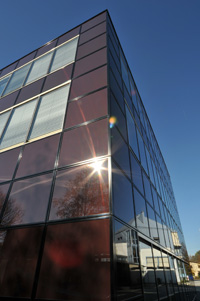New standard for building-integrated photovoltaics (BIPV) being drawn up The trend in the building envelope is no longer merely towards a reduction in U-values. Now there is also an increasing shift towards “multi-functionality” and energy generation. To support efforts in this area, the ift Rosenheim is closely involved in preparation of the product standard for building-integrated photovoltaic components. This standard will set out the requirements for photovoltaic components used in the building envelope.
There is an ever-growing market for the generation of clean electricity from photovoltaics. Not only are modules increasingly to be found in open outdoor spaces and on roofs, but photovoltaics are also being used more and more frequently in facades. Glass components offer considerable scope for developing these technologies, because not only their g-values, but also the energy generated by photovoltaic modules integrated in them have a positive impact on the energy balance of the facade. The IEC (International Electrotechnical Commission) requires that a separate standard be prepared for the structural requirements applicable to these components. Drafts of the standard are due to be completed by the end of 2011. The ift Rosenheim will participate in the European Standardisation Committee and support the process with its many years of experience in developing practical, easy-to-apply evaluation procedures, and its expertise in the technical design of components and the building envelope.
In addition, the ift already offers services relating to all the key aspects of BIPV, and is thus a comprehensive service provider for the application of photovoltaics in the building envelope.
Most photovoltaic modules consist of laminated glass panes onto which coatings have been applied, or solar cells facing into a laminate bond. Apart from PVB films, other films are also used in these applications. Products such as these are classified as laminated glass. If the product is to be used as laminated safety glass according to Construction Products List A, Part 1, and features a PVB or a different film, then it is a “non-regulated” product not covered by the standard. From the point of view of construction law, a PV module in the facade falls within the scope of the Technical Rules for Glazing Systems with Linear Support (TRLV), the Technical Rules for the Design and Detailing of Glazing Systems with Point Support (TRPV), the Technical Rules for the Use of Safety Barrier Glazing (TRAV), or – for structural sealant glazing systems – ETAG 002-1 and -2, depending on the specific application.
Use of these products in areas where laminated safety glass according to Construction Products List A, Part 1, Item 11.14 is required is therefore only possible on the basis of separate verifications in the context of an individual approval or a national technical approval.
In addition to stability, residual load bearing capacity, durability, and compatibility with other materials used in the building, building physics aspects such as light, thermal insulation and solar shading are also important. For designers and planners, the building physics characteristics of light transmittance and g-value in relation to the coverage ratio of the crystalline solar cells/partially transparent thin-film modules are relevant. 14/03/2011 |